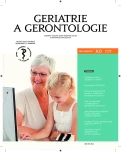Evaluation of physical capability among the elderly
Authors:
Mgr. Kateřina Macháčová, Ph.D.
Authors‘ workplace:
CELLO FHS UK, Praha
Published in:
Geriatrie a Gerontologie 2013, 2, č. 3: 131-133
Category:
Review Article
Overview
Certain level of physical capability is essential for independently performing all activities of daily living. The physical capability is determined by the level of individual components of physical fitness (muscular strength, endurance, flexibility, stability). All those components are affected by the aging processes. However, we can positively influence them (to slow down or postpone the onset of the processes), even late in life. Therefore it is in the interest of every individual as well as the whole society to take advantage of all possible preventive measures that will help older adults to live out the late stages of their lives in an active and happy manner. The most effective and at the same time inexpensive way is to include regular physical activity in a person’s everyday life. But any effective physical activity program must respect actual needs and capabilities of every individual. As a result the use of instruments developed to measure the level of physical capability is critical. The aim of this paper is to summarise and briefly describe various approaches to measuring physical capability among the elderly and to introduce standardized tools commonly used abroad (and some of them in Czech Republic as well).
Key words:
active ageing – physical capability – physical fitness – measurement
Sources
1. Rikli RE, Jones JC: Senior fitness test manual. Champain IL: Human Kinetics 2001.
2. Spirduso WW: Physical dimension of aging. 2 vyd. Champain IL: Human Kinetics 2005 : 384.
3. Mahoney FI, Barthel DW: Functional Evaluation: The Barthel Index. Md State Med J 1965; 14 : 61-65.
4. Katz S et al.: Studies of Illness in the Aged. The Index of Adl: A Standardized Measure of Biological and Psychosocial Function. JAMA 1963; 185 : 914–919.
5. Lawton MP, Brody EM: Assessment of older people: self-maintaining and instrumental activities of daily living. Gerontologist 1969; 9(3): 179–186.
6. Keith RA et al.: The functional independence measure: a new tool for rehabilitation. Adv Clin Rehabil 1987; 1 : 6–18.
7. Hall KM: The Functional Assessment Measure (FAM). J Rehabil Outcomes 1997; 1(3): 63–65.
8. Gerety MB et al.: Development and validation of a physical performance instrument for the functionally impaired elderly: the Physical Disability Index (PDI). J Gerontol 1993; 48(2): M33–38.
9. Ware JE Jr., Sherbourne CD: The MOS 36-item short-form health survey (SF-36). I. Conceptual framework and item selection. Med Care 1992; 30(6): 473–483.
10. Reuben DB et al.: A hierarchical exercise scale to measure function at the Advanced Activities of Daily Living (AADL) level. J Am Geriatr Soc 1990; 38(8): 855–861.
11. Reuben DB, Siu AL: An objective measure of physical function of elderly outpatients. The Physical Performance Test. J Am Geriatr Soc 1990; 38(10): 1105–1112.
12. Winograd CH et al.: Development of a physical performance and mobility examination. J Am Geriatr Soc 1994; 42(7): 743–749.
13. Cress ME et al.: Continuous-scale physical functional performance in healthy older adults: a validation study. Arch Phys Med Rehabil 1996; 77(12): 1243–1250.
14. Cress ME et al.: Continuous-scale physical functional performance test: validity, reliability, and sensitivity of data for the short version. Phys Ther 2005; 85(4): 323–335.
15. Bruce RA, Kusumi F, Hosmer D: Maximal oxygen intake and nomographic assessment of functional aerobic impairment in cardiovascular disease. Am Heart J 1973; 85(4): 546–562.
16. Osness WH, Adrian M, Clark B: Functional fitness assessment for adults over 60 years. Dubuque: Kendal: Hunt Publishing 1996.
17. Guralnik JM et al.: A short physical performance battery assessing lower extremity function: association with self-reported disability and prediction of mortality and nursing home admission. J Gerontol 1994; 49(2): M85–94.
18. Guralnik JM et al.: Validation and use of performance measures of functioning in a non-disabled older population: MacArthur studies of successful aging. Aging (Milano) 1994; 6(6): 410–419.
19. Netz J, Argot E: Assessment of functional fitness among independent older adults: a preliminary report. Percept Mot Skills 1997; 84 : 1059–1074.
20. Lemmink KAPM et al.: Reliability of the Groningen Fitness Test for the elderly. Journal of aging and physical activity 2001; 9 : 194–212.
21. Brach JS et al.: The association between physical function and lifestyle activity and exercise in the health aging and body composition study. J Am Geriatr Soc 2004; 52(4): 502–9.
Labels
Geriatrics General practitioner for adults Orthopaedic prostheticsArticle was published in
Geriatrics and Gerontology

2013 Issue 3
Most read in this issue
- The impact of physiotherapy on self-sufficiency of geriatric patients
- The little things in geriatrics – three case reports
-
Dokážeme včasně diagnostikovat poruchy polykání?
Časný screening poruch polykání, kazuistiky - Occupational therapy in patients suffering from dementia at a geriatric workplace
